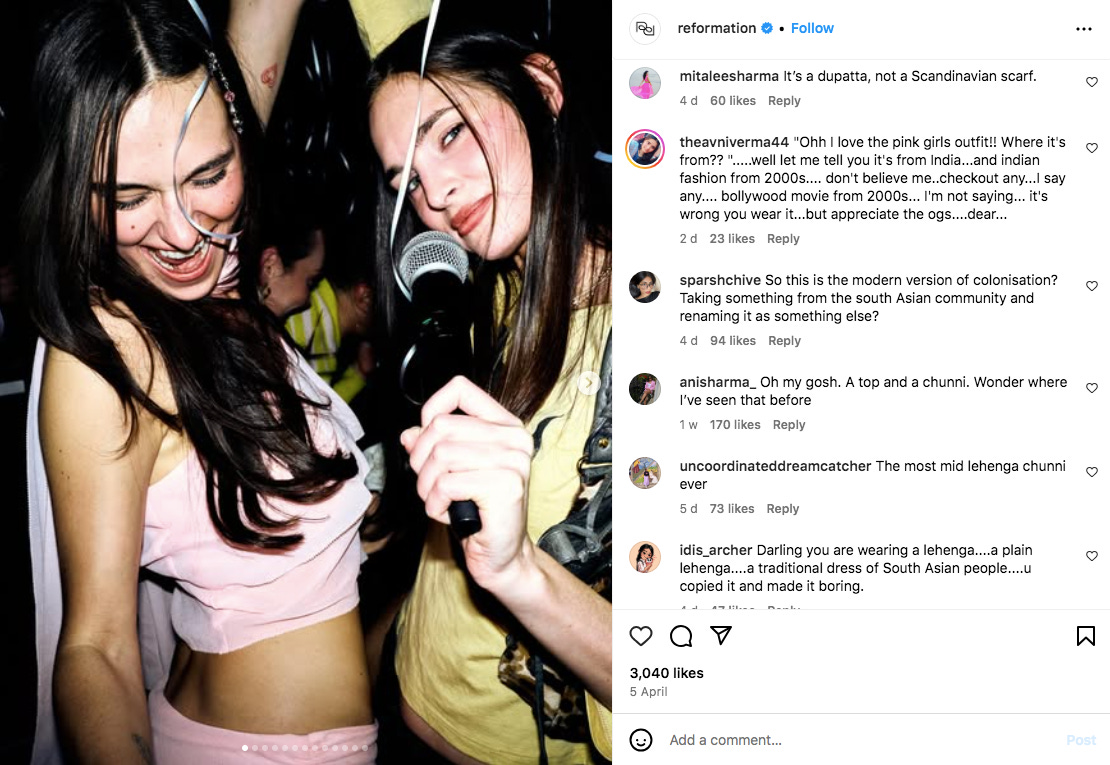Reformation Faces Accusations of Cultural Appropriation, Leaving South Asians and Scandinavians to Clear Up Confusion
A new brand collaboration with American influencer Devon Lee Carlson is causing the resurgence of a 'Scandinavian aesthetic' controversy, a wrongly labelled trend appropriating South Asian fashion
Pictures and promotional videos on Instagram and TikTok of the new Reformation spring collection, which recently dropped on March 31st, are being criticised for borrowing too heavily from South Asain culture.
One style in particular, a two-piece outfit in pink or light blue chiffon resembling a lehenga worn by model and influencer Devon Lee Carlson, is facing massive backlash. The top also has a thin scarf attached to the back and draped around the neck that looks similar to a dupatta.
Reformation took on the criticism and responded in a statement that they respected the online critique given South Asia’s influence on Western culture, but added that no items should be considered in isolation without their cultural or historical context.
This is, however, neither the first time nor the only fast fashion brand that has failed to acknowledge the style of their clothes as South Asian. Both H&M and Oh Polly offer garments that are frightfully similar to traditional South Asian clothes, passing them off as ‘European’.

Making South Asian traditional dresses palatable to white women is nothing new. Many of these clothes have historical importance tied to colonialism. Some commenters, therefore, argue that this is beyond cultural appropriation.
“So this is the modern version of colonisation? Taking something from the South Asian community and renaming it as something else?” user @sparshchive commented on one of Reformation’s Instagram posts.
The ‘something else’ refers to what is a dupatta, but falsely called a Scandinavian scarf, which is now stirring up even more fashion controversy.
Last year, American clothing rental service Bipty came under much scrutiny when an employee in a TikTok video (which has since been removed) described floral dresses with scarves across the chest as ‘very European’. The Tribune, a Pakistani publication, reported the story in 2024, outlining the trend South Asian creators were making in response, calling out the cultural appropriation.
Somehow, the ‘European’ style, and notably the scarf, has been branded as a Scandinavian aesthetic in the sarcastic retort. The resurfacing of critique since Reformation’s Devon Lee Carlson collaboration launch has left many Scandinavians confused, as the term ‘Scandinavian scarf’ is now trending on TikTok.
The overwhelming majority of TikTok users point out that the scarf is indeed not Scandinavian, but a dupatta. And Scandinavians are coming to their own defence, emphasising that shawls and scarves worn across the Nordic countries bear no resemblance to the skinny scarves trending right now.
One commenter wrote: “This whole situation is not only erasing South Asian culture, but also Scandinavian culture since we have our own cultural clothing and styles.”
The perception of some garments as finer, of higher status, luxurious, and chic when presented on a white woman highlights the tension and power imbalance in fashion. Passing the traditional South Asian styles off as white, European, or Scandinavian, all the while offering products of lower quality than the originals, (the lehenga and dupatta two-piece outfit will set you back $500 and is made of polyester), is discouraging on many levels.
The problem could have been avoided if brands had collaborated with South Asian designers; offering the actual product; or simply acknowledging the culture from which the design of their clothes had been inspired.
However, the controversy and cultural appropriation accusations (although we’ve been here before) may lend themselves to be a learning opportunity. Knowing that these popular and ‘trendy’ garments are taken from South Asian culture offers an educational moment on fashion history, garment design, and fabric and their values that might just tear us from the glorification of fast fashion.
It is an optimistic outlook, but with TikTok becoming a less unorthodox means of sharing knowledge there is still hope.







loved this one julie!!! -b :)